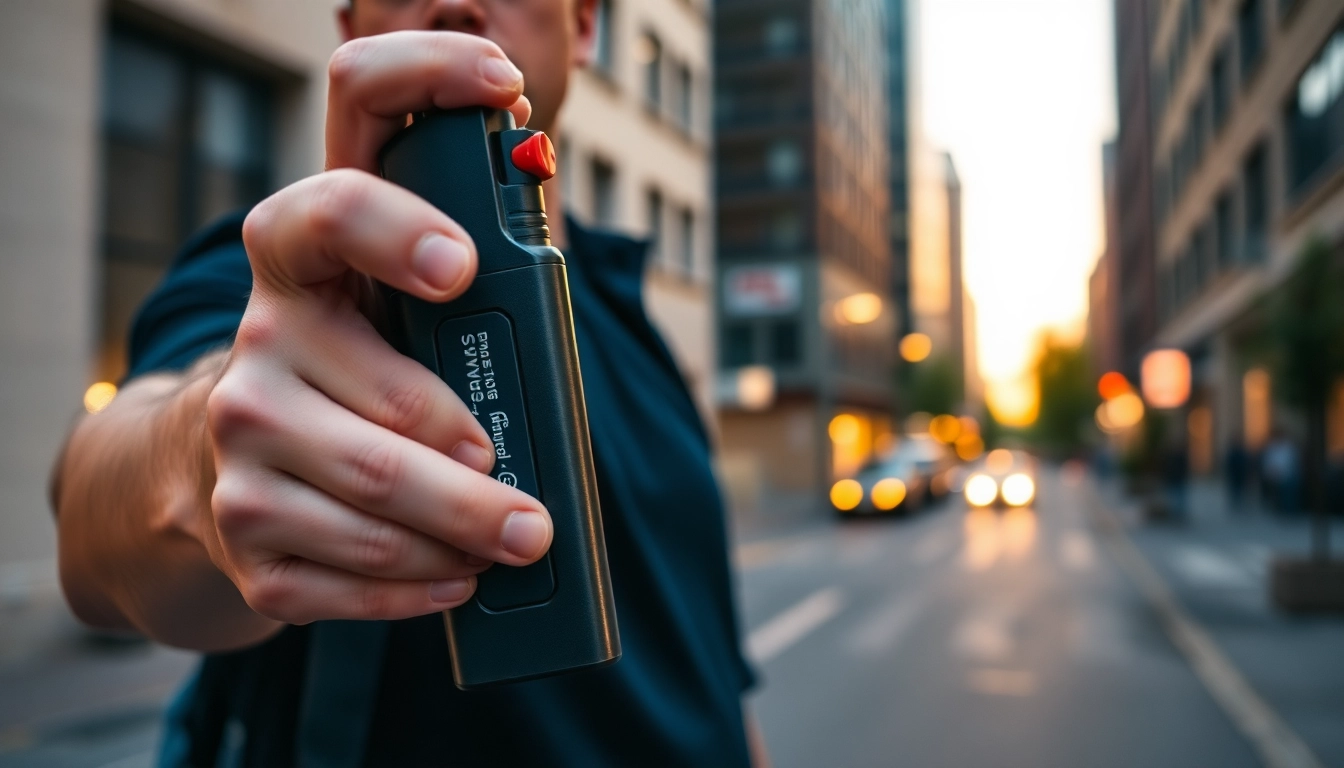
Understanding Pepper Spray: Basics and Uses
What is Pepper Spray?
Pepper spray is a non-lethal self-defense tool that consists of a mixture of capsaicin, the active component in chili peppers, and propellants. When sprayed, it creates an intense burning sensation in the eyes and skin, leading to temporary blindness and severe discomfort. People often carry pepper spray for personal protection against potential attackers, aggressive animals, or life-threatening situations. The effectiveness of pepper spray is enhanced by its ability to rapidly incapacitate an assailant, allowing the user to escape danger. Additionally, it typically has a shelf life of three to four years, making it a long-lasting option for personal safety measures.
Common Applications of Pepper Spray
Pepper spray is widely used in various contexts, primarily as a self-defense tool. Some of the most noted applications include:
- Personal Self-Defense: Many individuals carry pepper spray as a means of self-defense against muggings, sexual assaults, or other violent confrontations. Its accessibility and ease of use make it a favored option.
- Law Enforcement: Police and security personnel often utilize pepper spray for crowd control during riots or protests, as it provides a less lethal means of dispersing crowds.
- Animal Deterrent: Hikers and outdoor enthusiasts may use pepper spray to deter aggressive wildlife, including bears and dogs, providing an additional layer of safety while enjoying the outdoors.
- Home Protection: Some people keep pepper spray in their homes as a safety measure against intruders, allowing for a quick response in alarming situations.
Legal Considerations Surrounding Pepper Spray
Before acquiring pepper spray, it’s crucial to understand the legal ramifications surrounding its possession and use, which can vary widely by region and jurisdiction. In many places, there are restrictions on:
- Size and Strength: Some jurisdictions limit the size of canisters and the concentration of active ingredients.
- Usage Regulations: The use of pepper spray for self-defense is generally legal, but using it for intimidation or in non-threatening scenarios may result in legal consequences.
- Ages of Possession: Certain areas require individuals to be of a specific age to carry pepper spray legally, often set at 18 years or older.
Potential users should consult local laws and regulations to ensure compliance and safety when using pepper spray for self-defense.
Choosing the Right Pepper Spray: Key Features to Consider
Types of Formulations and Effects
Pepper sprays come in various formulations, each designed for specific purposes. The most common types include:
- OC (Oleoresin Capsicum) Spray: This is the most widely used formulation, containing the active compound extracted from hot peppers. It causes immediate inflammation and irritation of mucous membranes.
- CS Gas (Tear Gas): While not a pepper spray in the traditional sense, CS gas is often classified as a chemical agent. It can cause tears, skin irritation, and respiratory issues but generally has a broader area of effect.
- Combination Formulations: Some pepper sprays combine OC with CS gas or other agents to enhance their effectiveness. These formulations may be used for both self-defense and law enforcement purposes.
Size and Portability of Pepper Spray
The size and portability of your chosen pepper spray can greatly influence its usability. When selecting a canister, consider the following factors:
- Canister Size: Smaller, more compact canisters are easy to carry in pockets, purses, or on keyrings, making them more likely to be accessible during an emergency.
- Spray Range: Most pepper sprays provide effective range between 8 to 10 feet. Understanding the range can help users select a product that allows for safety without getting too close to a potential threat.
- Weight: Lightweight options can ensure ease of carrying, whereas bulkier ones might offer more concentrated doses but may be cumbersome.
Safety Features and Usage Instructions
When selecting a pepper spray, it’s important to consider its safety features to avoid accidental discharge:
- Safety Lock: Many modern pepper sprays come with a safety lock to prevent unintentional sprays.
- Finger Grip: A finger grip provides better control and more accurate aiming when deploying the spray.
- Instructional Labels: Clear usage instructions and warnings on the packaging can aid in safe and effective deployment during critical moments.
Effective Techniques for Using Pepper Spray
Proper Aiming and Distance
Effective use of pepper spray requires careful attention to aiming and maintaining a safe distance from an assailant. Follow these guidelines:
- Aim for the Face: Specifically target the eyes and face for the most effective impact.
- Maintain Your Distance: Use the range of your canister to keep the attacker at bay; generally, aim for distances of about 8-10 feet.
- Bear Downwind: When deploying the spray, ensure that you are not in the wind’s path, as this could affect the spray’s trajectory.
Practicing Responsible Usage
Responsible usage of pepper spray is essential to ensure it serves its intended purpose without causing unnecessary harm:
- Know Your Environment: Be aware of your surroundings and identify possible escape routes before using the spray.
- Flee if Possible: Pepper spray should be used only when escape is not an option, as avoidance is the best tactic.
- Training: Consider formal self-defense training that incorporates pepper spray use to build confidence and effectiveness.
Tips for Maintaining Your Pepper Spray
Maintaining your pepper spray is crucial to ensure it is functional when you need it. Key maintenance tips include:
- Store Properly: Keep it in a cool, dry place away from direct sunlight, as extreme heat can degrade the effectiveness of the spray.
- Check Expiration Dates: Periodically check the expiration date and replace expired canisters promptly to ensure potency.
- Regular Testing: Some experts recommend practicing with a test spray in a safe environment (only if permitted) to familiarize yourself with the canister’s operation.
Comparative Analysis: Pepper Spray vs. Other Self-Defense Tools
Advantages of Using Pepper Spray
When compared to other self-defense tools, pepper spray offers several advantages:
- Non-Lethal Option: It incapacitates an attacker without causing permanent injury, making it a preferred choice for individuals who are concerned about the consequences of lethal force.
- Ease of Use: It can be swiftly deployed without the need for extensive training, allowing users to respond quickly in emergencies.
- Portability: Its compact size allows it to be carried almost anywhere, making it an accessible form of personal safety.
When to Use Pepper Spray vs. Alternatives
Understanding when to use pepper spray is key to effective self-defense:
- Consider the Threat Level: If an assailant poses an imminent threat, pepper spray may be justified. For potential unarmed confrontations, verbal de-escalation may be worth attempting before resorting to physical means.
- Alternatives to Consider: In close-quarters situations, tactical self-defense techniques or non-lethal items like personal alarms may better suit the scenario without escalating violence.
Evaluating Personal Self-Defense Needs
Each individual’s self-defense needs are unique. When evaluating whether to carry pepper spray, consider the following:
- Your Environment: Urban areas may present different threats compared to rural settings. Tailor your self-defense tools to your lifestyle.
- Your Comfort Level: Assess your comfort with carrying and potentially using pepper spray. Some may prefer non-physical deterrents, such as alarms or whistles.
Conclusion: Empowering Your Safety with Pepper Spray
Maintaining Awareness and Readiness
Staying aware of your surroundings and being ready to respond is crucial for personal safety. Regularly practice being observant and proactive, which can enhance your chances of avoiding dangerous situations.
Resource Recommendations for Further Learning
To better understand pepper spray and its proper use, consider educational resources such as books on self-defense, online courses, and community workshops. Engaging with knowledgeable instructors can provide practical skills and boost your confidence in emergency situations.
Final Thoughts on Personal Safety Strategies
Incorporating pepper spray as a self-defense option can empower individuals to take proactive steps toward their safety. While no device is foolproof, understanding its applications, limitations, and proper use can provide peace of mind. Remember, the most effective self-defense strategy involves a combination of awareness, avoidance, and prepared responses, including the use of effective self-defense tools.





